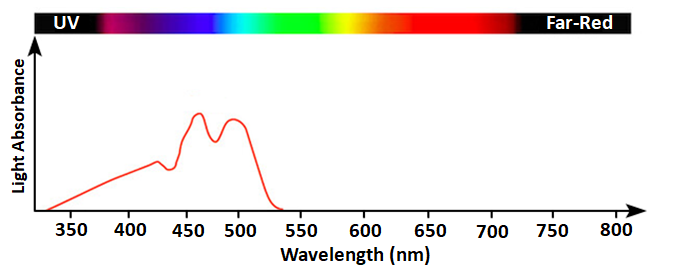The Engelmann experiment shown in the given diagram helped to understand the relationship between:

1.
bacteria and the alga used in the experiment.
2.
the rate of respiration in aerobic bacteria and wavelengths of light.
3.
wavelengths of light and the oxygen released during photosynthesis.
4.
rates of oxygen liberation by alga and carbon dioxide liberated by the bacteria.

Identify the incorrectly matched pair:
| 1. | PS I | P700 is reaction center |
| 2. | RuBP | 5 carbon compound |
| 3. | PS II | P680 is reaction center |
| 4. | C3 plants | Kranz anatomy |

To unlock all the explanations of 38 chapters you need to be enrolled in MasterClass Course.

To unlock all the explanations of 38 chapters you need to be enrolled in MasterClass Course.
The given diagram shows the scheme of:
| 1. | Cyclic photophosphorylation and Y is NADPH |
| 2. | Cyclic photophosphorylation and Y is ATP |
| 3. | Non-Cyclic photophosphorylation and Y is NADPH |
| 4. | Non-Cyclic photophosphorylation and Y is ATP |

To unlock all the explanations of 38 chapters you need to be enrolled in MasterClass Course.

To unlock all the explanations of 38 chapters you need to be enrolled in MasterClass Course.
If you ran the Engelmann experiment without passing light through a prism, what would you predict?
| 1. | The results will be unaffected. |
| 2. | Even distribution along the length. |
| 3. | Accumulation only in red wavelength zone. |
| 4. | More cluster in the middle than at the ends. |
The correct statements about photosynthesis include:
| I: | the light-dependent reactions can occur only in the light, the light-independent reactions only in the dark |
| II: | photorespiration is more efficient at producing glucose than is photosynthesis |
| III: | the light-dependent reactions produce the energy-rich compounds that are used to run the light-independent reactions |
| 1. | I only | 2. | III only |
| 3. | I and III only | 4. | II and III only |

To unlock all the explanations of 38 chapters you need to be enrolled in MasterClass Course.

To unlock all the explanations of 38 chapters you need to be enrolled in MasterClass Course.
In cyclic electron flow:
| 1. | the electron begins in a pigment complex called photosystem I, passes from the primary acceptor to ferredoxin and then to plastoquinone, then to cytochrome b6f, and then to plastocyanin before returning to chlorophyll. |
| 2. | the electron begins in a pigment complex called photosystem II, passes from the primary acceptor to ferredoxin and then to plastoquinone, then to cytochrome b6f, and then to plastocyanin before returning to chlorophyll. |
| 3. | the electron begins in a pigment complex called photosystem I, passes from the primary acceptor to ferredoxin and then to plastocyanin, then to cytochrome b6f, and then to plastoquinone before returning to chlorophyll. |
| 4. | the electron begins in a pigment complex called photosystem II, passes from the primary acceptor to ferredoxin and then to plastocyanin, then to cytochrome b6f, and then to plastoquinone before returning to chlorophyll. |
Study the given diagram where ‘X’ represents the absorption spectrum of chlorophyll a and ‘Y’ represents the action spectrum of photosynthesis. The conclusions that can be drawn include:
| I: | Chlorophyll a is the main pigment in photosynthesis. |
| II: | Violet-Blue and Red wavelengths are very effective for photosynthesis. |
| III: | Chlorophyll a is the only pigment capable of absorbing light. |
| 1. | I and II only | 2. | I and III only |
| 3. | II and III only | 4. | I, II and III |

To unlock all the explanations of 38 chapters you need to be enrolled in MasterClass Course.

To unlock all the explanations of 38 chapters you need to be enrolled in MasterClass Course.
Identify the correct relationship between photosynthesis and cellular respiration:
| 1. | while only autotrophs photosynthesize, only heterotrophs respire |
| 2. | while photosynthesis uses solar energy to convert inorganics to energy-rich organics, respiration breaks down energy-rich organics to synthesize ATP |
| 3. | photosynthesis occurs in day time and respiration at night |
| 4. | ATP cannot be formed during photosynthesis, it can only be formed in cellular respiration. |

To unlock all the explanations of 38 chapters you need to be enrolled in MasterClass Course.

To unlock all the explanations of 38 chapters you need to be enrolled in MasterClass Course.
The absorption spectrum shown in the given figure can be of:
1. Chlorophyll a
2. Chlorophyll b
3. Carotenoids
4. Either 1 or 2
Identify the incorrect statement regarding non-cyclic photophosphorylation:
| 1. | Being a light reaction, non-cyclic photophosphorylation occurs in the thylakoid membrane. |
| 2. | The photosystem II complex replaces its lost electrons from an external source. |
| 3. | It generates both ATP and NADPH |
| 4. | When the chloroplast runs low on ATP for the Calvin cycle, the plant may shift from cyclic to non-cyclic electron flow. |










